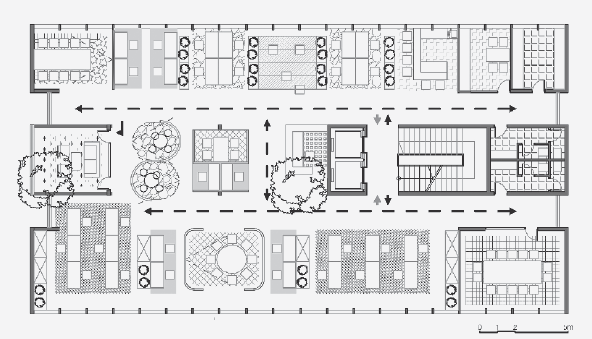Towards a Model of Resilient, Sustainable and Productive Post-Covid Work Environment
Hybrid Solution for Podgorica, Montenegro
DOI:
https://doi.org/10.31522/p.32.2(68).5Keywords:
hybrid work solutions, post-pandemic office, resilient office, sustainable office, work from homeAbstract
The Covid-19 pandemic has significantly changed the work perception and attitudes of employees. The goal of this research is to identify the experience of the beneficiaries and provide guidelines to develop an optimal model of the working environment during and in the post-pandemic period. The study is focused on an anonymous survey comprising 34 combined questions conducted online among 202 responders, including general questions, the issue of working conditions in offices, manner of transforming working conditions during the pandemic and personal perception of comfort. The questionnaire is also related to transitive solutions, work from home and the accentuation of a favourite manner of work upon the end of the pandemic. The results of the questionnaire together with theoretical analyses of this research may be useful for creating a good basis for the definition of optimal work spaces in the post-pandemic period, in order to further direct the development of resilient work spaces on the territory of Podgorica, as a case study. The study may be also applied to other contexts.
References
Aksamija, A.; Milosevic, S. (2023) ‘Post-Pandemic Office Spaces: Considerations and Design Strategies for Hybrid Work Environments‘. Enquiry The ARCC Journal for Architectural Research, 20(1), Sept. 2023, pp. 41-64, https://doi.org/10.17831/enqarcc.v20i1.1192
Amir, M.; Khan, S.Z. (2022) ‘Assessment of renewable energy: Status, challenges, COVID-19 impacts, opportunities, and sustainable energy solutions in Africa‘. Energy and Built Environment, 3(3), pp. 348-362. https://doi.org/10.1016/j.enbenv.2021.03.002
Bhamra, T.; Lofthouse, V. (2016) Design for Sustainability: A Practical Approach. Florida: CRC Press. https://www.taylorfrancis.com/books/mono/10.4324/9781315576664/design-sustainability-tracy-bhamra-vicky-lofthouse
Colenberg, S.; Keyson, D. (2021) ‘Expected user needs towards the post-Covid office: better support of social interactions and con-centration‘, Conf. The 20th EuroFM Research Symposium.
Dale, K.; Burrell, G. (2007) The spaces of organisation and the organisation of space: Power, identity and materiality at work. Basingstoke: Palgrave Macmillan. https://doi.org/10.5040/9781350389373
Dias, P.; Ruão, T.; Andrade, J.; Duarte, A. (2023) ‘Perspectives on Workplace Communication and Well-Being in Hybrid Work Environments‘. IGI Global, https://doi.org/10.4018/978-1-6684-7353-5
Echegaray, F. (2021) ‘What POST-COVID-19 lifestyles may look like? Identifying scenarios and their implications for sustainability‘. Sustainable Production and Consumption, 27, pp. 567-574. https://doi.org/10.1016/j.spc.2021.01.025
Federation of Employers of Montenegro (2021) COVID-19 CRISIS RESPONSE: Challenges, needs and expectations of Montenegrin companies, second survey among companies. March 2021 [online]. Available at: https://www.poslodavci.org/biblioteka/publikacije/izvjestaj-odgovor-na-krizu-covid-19-izazovi-potrebe-i-ocekivanja-crnogorskih-preduzeca [Accessed: 5 march 2024]
Gupta, A.; Bajaj, D. (2023) ‘Commercial office portfolio risks during the COVID pandemic and the future beyond - a survey of stakeholders in India‘. Journal of Property Investment & Finance, 41. https://doi.org/10.1108/JPIF-03-2023-0019
Ipsen, C.; van Veldhoven, M.; Kirchner, K.; Hansen, J.P. (2021) ‘Six Key Advantages and Disadvantages of Working from Home in Europe during COVID-19‘, Int. J. Environ. Res. Public Health 18: 1826. https://doi.org/10.3390/ijerph18041826
Jeska, S. (2002) ‘The effects of information technology on corporate structures‘. In: T. Arnold, R. Hascher, S. Jeska, & B. Klauck (Eds.), A design manual: Office buildings. Birkhauser: Basel, pp. 25-28.
Kamis, J.; Rahim, Z.; Yusoff, Y.; Husin, N. A.; Yuliviona, R. (2023) ‘A Review on Hybrid Work and Work Performance during Post-Pandemic‘. KnE Social Sciences. https://doi.org/10.18502/kss.v8i13.13756
Monstat (2020) Directorate of Statistics. Creating a subsystem of official statistics for the needs of the Covid-19 pandemic research, 2020 [online]. Available at: http://monstat.org/uploads/files/publikacije/Kreiranje%20podsistema%20zvani%C4%8Dne%20statistike_3dec_online.pdf [Accessed: 10 march 2024]
Monstat (2021) Number and structure of business entities in Montenegro in 2020, 30 March 2021 [online]. Available at: http://www.monstat.org/cg/novosti.php?id=3511 [Accessed:10 November 2021]
Nagy, G.; Adnan, H. (2022) ‘A Guideline for Developing Resilient Office Buildings using Nanotechnology Applications‘. IOP Conference Series: Earth and Environmental Science, 1056 (1):012015. https://doi.org/10.1088/1755-1315/1056/1/012015
O’Neill, M. (2014) How Will We Design the Offices of the Future? ArchDaily. Dostupno na: www.archdaily.com/545412/how-will-we-design-the-offices-of-the-future [Maj 2021]
Paunović Žarić, S. (2022) Building envelope as a generator of visual and thermal comfort - administrative workspaces in the Podgorica, Montenegro, Ph.D. thesis, University of Sarajevo, Faculty of Architecture.
Richter, A.; Richter, S. (2024) ‘The 3p model of hybrid work: practices, protocols, persistency‘. Conf. ECIS 2024 - Thirty second European Conference on Information Systems.
Ross, P. (2012) ‘Typology: Offices‘, The Architectural Review, July 24 [online]. Available at: https://www.architectural-review.com/essays/typology/typology-offices [Accessed: 5 March 2024].
Sailer, K.; Thomas, M.; Pachilova, R. (2023) ‘The challenges of hybrid work: an architectural sociology perspective’, Buildings and Cities, 4(1), pp. 650-668. https://doi.org/10.5334/bc.350
Simanjuntak, N.; Maarif, M.; Kuswanda, H. (2023) ‘Scenario Planning of Hybrid Working Model Effectivity (Work From Home & Work From Office)‘ at PT. XYZ’. Business Review and Case Studies, 4. https://doi.org/10.17358/brcs.4.2.173
Tanis, J. (2008) Workspace and Behavior Future Office: Design, Practice and Applied Research. Grech, C.; Walters, D. eds. Routledge: New York, pp. 10-11.
Tokazhanov, G.; Tleuken, A.; Guney, M.; Turkyilmaz, A.; Karaca, F. (2020) ‘How is COVID- 19 Experience Transforming Sustainability Requirements of Residential Buildings? A Review‘, Sustainability, 12: 8732. https://doi.org/10.3390/su12208732
Utama, A.A.G.S. (2023) ‘The future of work: Exploring human resource trends and innovations in the post-covid-19 era‘. 4, pp. 467-474.
Van den Dobbelsteen, A.A.J.F. (2004) ‘The Sustainable Office: an exploration of the potential for factor 20 environmental improvement of office accommodation‘, Ph.D. Thesis. TU Delft: Delft, pp. 23-27.
Zeller, D. (2017) ‘The Hybrid Work Environment: The Business Process Argument for Adapting Organizational Structure‘, 5 February 2024 [online]. Available at: https://doi.org/10.5281/zenodo.1040845
Zeller, D. (2020) ‘The Hybrid Virtual / Traditional Office Work Environment: Business Processes and Task Uncertainty‘, 5 February 2024 [online]. Available at: https://doi.org/10.5281/zenodo.4234416

Downloads
Published
How to Cite
Issue
Section
License
Copyright (c) 2024 Sanja Paunović Žarić , Svetlana K. Perović, Ema Alihodžić Jašarović

This work is licensed under a Creative Commons Attribution 4.0 International License.
Copyright (c) 2021 authors and journal.
This work is licensed under a Creative Commons Attribution 4.0 International License.
Authors who publish with this journal agree to the following terms:
In agreeing this form, you certify that:
- You read the ethical codex of the PROSTOR available at journal web.
- You submitted work is your original work, and has not previously been published and does not include any form of plagiarism.
- You own copyright in the submitted work, and are therefore permitted to assign the licence to publish to PROSTOR.
- Your submitted work contains no violation of any existing copyright or other third party right or any material of an obscene, libellous or otherwise unlawful nature.
- You have obtained permission for and acknowledged the source of any illustrations, diagrams or other material included in the work of which you are not the copyright owner.
- You have taken due care to ensure the accuracy of the work, and that, to the best of your knowledge, there are no false statements made within it.
- All co-authors of this submitted work are aware of, and in agreement with, the terms of this licence and that the submitted manuscript has been approved by these authors.






